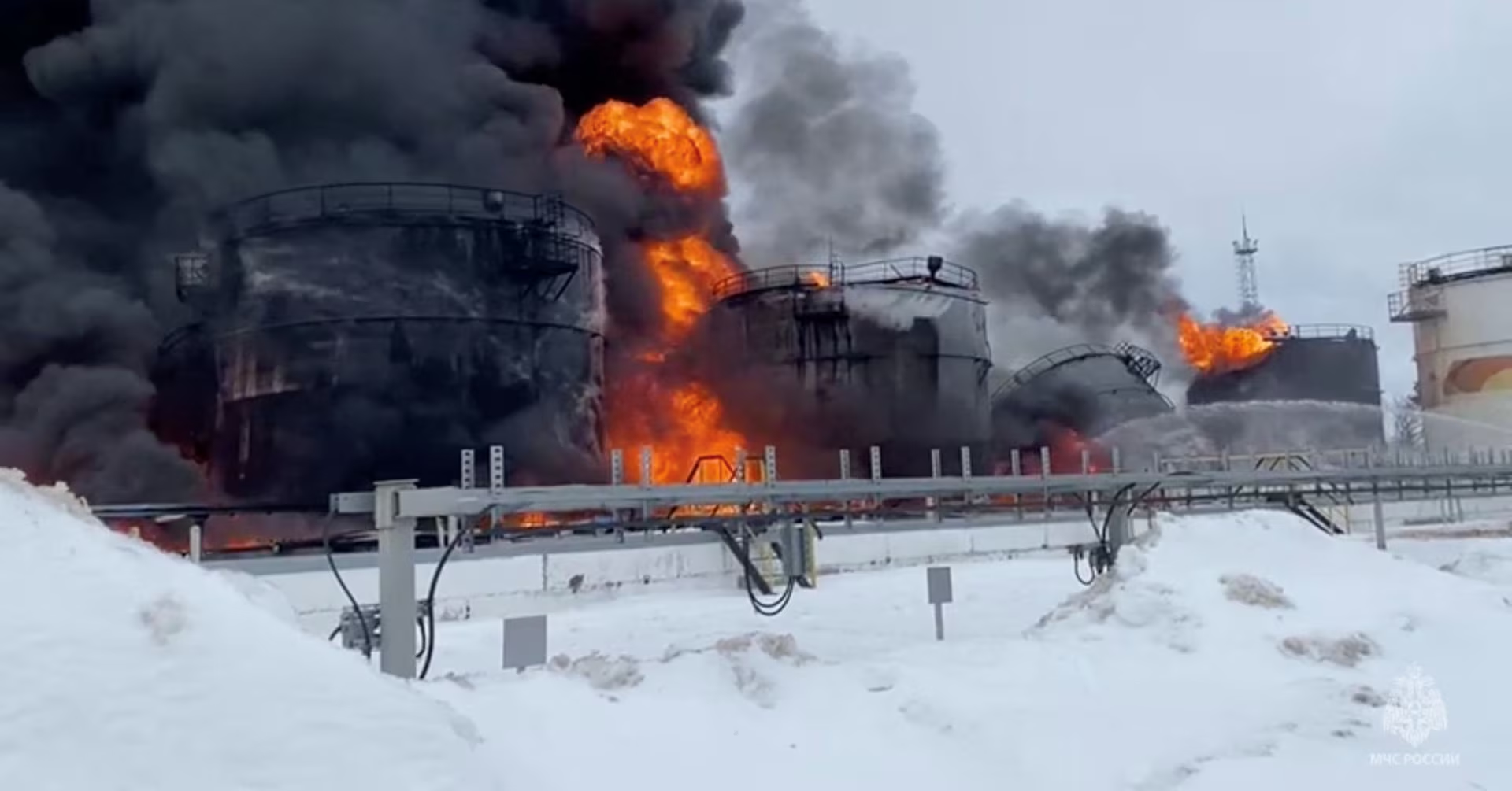The war between Ukraine and Russia has entered a new and audacious phase with Ukrainian drones striking deep into Russian territory, targeting one of Moscow’s most critical oil facilities. This bold attack not only disrupted energy production but also sent a clear message about Kyiv’s evolving military capabilities and strategic intent.
- The Drone Attack That Shook Russia’s Energy Hub
- Why Oil Facilities Are Prime Targets
- The Evolution of Ukraine’s Drone Warfare
- Russia’s Response and the Security Dilemma
- Global Energy Market Implications
- The Strategic Calculus for Ukraine
- Expert Perspectives on the Escalation
- The Role of Western Support
- The Human and Environmental Cost
- A Symbolic Turning Point
- Looking Ahead: What This Means for the War
- FAQs
- Why did Ukraine target a Russian oil facility?
- How significant was the damage from the drone strike?
- Will this attack raise global oil prices?
- Could this provoke greater retaliation from Russia?
- What role do Western countries play in these strikes?
- Conclusion
The strike highlights Ukraine’s growing reliance on innovative warfare methods to offset Russia’s numerical and technological superiority, while also raising concerns about global energy markets, regional security, and the future trajectory of the conflict. As tensions escalate, the world is watching closely to understand how this attack could reshape battlefield dynamics and international relations.
The Drone Attack That Shook Russia’s Energy Hub
Reports from Russian state media and independent sources confirmed that a wave of Ukrainian drones managed to penetrate Russian air defenses and strike an oil processing facility in a key industrial region. The facility, believed to play a central role in refining and distributing petroleum products across Russia and abroad, erupted in flames after multiple explosions. Emergency services scrambled to contain the fire, with videos circulating online showing thick plumes of black smoke billowing into the sky.
For Ukraine, this attack was not merely a tactical maneuver but a strategic demonstration of its ability to hit Russia where it hurts most—its energy sector. Oil and gas remain the lifeblood of the Russian economy, providing nearly half of its federal budget revenues. By striking a major facility, Ukraine aims to weaken Russia’s financial capacity to sustain its military operations, while simultaneously signaling that the Kremlin is not immune to retaliation for its relentless bombardment of Ukrainian cities.
Why Oil Facilities Are Prime Targets
Russia’s vast oil infrastructure has long been considered one of its greatest strengths and vulnerabilities. Energy exports, particularly crude oil and natural gas, are critical for sustaining the Russian state and funding the war effort. Analysts note that by targeting oil refineries, storage depots, and export terminals, Ukraine is striking at the heart of Russia’s war chest.
According to the International Energy Agency, Russia exported around 7.6 million barrels per day of crude and refined products in 2024, despite Western sanctions. Interruptions to such facilities could potentially disrupt global oil prices, adding further pressure on Moscow while drawing international attention to Ukraine’s cause. As one defense analyst observed, “For every missile Russia fires at Ukrainian civilians, a drone sent to damage its economic engine is both symbolic and strategic.”
The Evolution of Ukraine’s Drone Warfare
When the war began in February 2022, few anticipated the scale at which drones would become decisive. Ukraine has rapidly developed indigenous drone production capabilities, supported by Western technology and private-sector innovation. Once reliant on Turkish-made Bayraktar TB2 drones, Ukraine now deploys a wide array of domestically built long-range unmanned aerial vehicles capable of reaching hundreds of kilometers into Russian territory.
These drones, often cheaper than advanced missiles, allow Ukraine to conduct asymmetric warfare. By overwhelming Russian air defenses with swarms of drones, Ukraine forces Moscow to expend expensive interceptor missiles on relatively low-cost targets. Over time, this strategy exhausts Russian resources and exposes vulnerabilities in its defense networks.
Russia’s Response and the Security Dilemma
The Kremlin reacted with fury to the strike, accusing Ukraine of terrorism and threatening retaliation. Russian defense officials claimed their air defenses had intercepted several drones but acknowledged that some had penetrated and caused significant damage. Moscow vowed to strengthen security around vital infrastructure, but the vast scale of its energy network makes it nearly impossible to fully protect.
This raises a troubling dilemma for Russia: divert resources to protect domestic infrastructure or concentrate on offensive operations in Ukraine. Either choice strains its military capacity. Moreover, each Ukrainian strike deep inside Russia undermines Moscow’s narrative of control and invulnerability, potentially fueling domestic discontent.
Global Energy Market Implications
Beyond the battlefield, the attack reverberates across global energy markets. Oil prices spiked immediately after reports of the facility fire, reflecting concerns over supply disruptions. Although Russia still exports large volumes despite sanctions, its reduced refining capacity could impact both domestic consumption and export potential.
European nations, already working to wean themselves off Russian energy, welcomed the development as evidence of Moscow’s economic fragility. However, countries dependent on Russian oil, including several in Asia, worried about price volatility and potential shortages. The incident underscores how closely intertwined the war is with global energy security, making every attack on oil infrastructure an event with worldwide consequences.
The Strategic Calculus for Ukraine
For Kyiv, the rationale behind striking oil facilities is both military and psychological. Militarily, degrading Russia’s energy production weakens its ability to fuel tanks, aircraft, and supply chains. Psychologically, it sends a message to both Russians and the international community that Ukraine can strike beyond the frontlines and impose costs on the aggressor.
President Volodymyr Zelensky has repeatedly stated that Ukraine will use all available means to defend its sovereignty and ensure that Russia pays for its invasion. Striking strategic economic assets aligns with this doctrine, especially as Western aid fluctuates amid political debates in Washington and Brussels.
Expert Perspectives on the Escalation
Security analysts are divided on whether targeting Russian oil facilities could escalate the war to dangerous levels. Some argue that these attacks are a legitimate form of warfare, striking military-relevant targets that fund and supply aggression. Others warn that hitting deep inside Russian territory risks provoking harsher retaliatory strikes, possibly against critical infrastructure in Ukraine or beyond.
Retired U.S. General Ben Hodges commented, “Ukraine is using the tools at its disposal to offset Russia’s overwhelming numbers. These strikes are not reckless—they are carefully calculated to shift the balance of power.” However, Russian commentators have warned that repeated strikes could push Moscow to expand its targeting scope or employ more destructive weapons.
The Role of Western Support
Ukraine’s growing ability to conduct long-range drone strikes has been bolstered by Western support, though not always directly. While the United States and Europe have provided advanced air defenses and precision weapons, Kyiv has invested heavily in its own drone industry, often supported by private fundraising campaigns and partnerships with Western tech firms.
Still, Western governments tread carefully, wary of being accused of directly enabling strikes inside Russia. This delicate balance reflects the complexity of sustaining Ukraine’s defense without crossing thresholds that could widen the conflict. Nevertheless, the success of these operations demonstrates how Ukrainian innovation, combined with external assistance, continues to reshape the war.
The Human and Environmental Cost
While the military and economic implications dominate headlines, the attack also raises concerns about human and environmental costs. Fires at oil refineries release toxic pollutants into the atmosphere, threatening nearby communities. Russian emergency services reported several injuries among facility workers, though casualties appear limited. Environmental experts warn that repeated attacks on energy infrastructure could lead to severe ecological damage, compounding the humanitarian toll of the war.
A Symbolic Turning Point
Perhaps the most significant aspect of the strike is its symbolism. For much of the conflict, Russia projected itself as insulated from direct attacks on its homeland. By hitting a critical oil facility, Ukraine has shattered that perception. The message is clear: Russia cannot wage war with impunity while expecting its own population and infrastructure to remain untouched.
This shift in perception could influence Russian public opinion, particularly among urban populations who have so far felt distant from the war’s frontlines. If energy shortages, rising prices, or recurring attacks become the new reality, pressure on the Kremlin may grow.
Looking Ahead: What This Means for the War
The drone strike on Russia’s oil facility is unlikely to be the last. Ukraine has shown determination to expand its reach and increase the costs of Russia’s aggression. As both sides prepare for another winter of fighting, attacks on energy infrastructure—whether in Ukraine or Russia—will play a pivotal role in shaping outcomes.
For the international community, the challenge lies in balancing support for Ukraine’s defense with efforts to prevent wider escalation. Global markets, environmental concerns, and humanitarian issues all intersect with military strategy in ways that make this conflict one of the most complex geopolitical crises of the 21st century.
FAQs
Why did Ukraine target a Russian oil facility?
Ukraine targeted the facility to weaken Russia’s economic and military capacity. Oil revenues fund Moscow’s war effort, and disrupting refining and distribution strikes at the heart of its ability to sustain operations.
How significant was the damage from the drone strike?
While Russian authorities downplayed the incident, independent reports suggest the damage was substantial, with fires disrupting refining operations. Exact assessments remain unclear due to restricted access, but the strike demonstrated Ukraine’s long-range capabilities.
Will this attack raise global oil prices?
Yes, markets reacted immediately with a spike in oil prices. The long-term impact depends on whether more such attacks occur and how much Russia’s refining capacity is reduced.
Could this provoke greater retaliation from Russia?
There is a risk that Moscow could escalate in response. However, Ukraine has calculated that striking economic targets is a legitimate means of self-defense. Western allies continue to monitor the situation to prevent uncontrolled escalation.
What role do Western countries play in these strikes?
While Western nations supply Ukraine with weapons and air defenses, most of the drones used in such attacks are domestically developed or privately funded. Western governments avoid direct involvement in strikes on Russian soil to reduce escalation risks.
Conclusion
The Ukrainian drones striking a major Russian oil facility mark a dramatic shift in the war’s trajectory, signaling Kyiv’s intent to impose costs on Moscow beyond the battlefield. By hitting at the heart of Russia’s economic power, Ukraine is redefining the conflict’s scope, showcasing resilience and ingenuity in the face of adversity.
The attack reverberates far beyond the immediate blast site—shaping global energy markets, testing geopolitical alliances, and challenging the Kremlin’s narrative of invulnerability. As the war grinds on, one thing is certain: Ukraine’s bold strategy of targeting oil infrastructure has opened a new chapter in this conflict, with consequences that will resonate across Russia, Ukraine, and the world.





